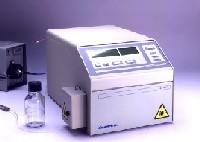|
Instrument Database:
Prince Technologies B.V. - ZETA LIF detector
| |
|

|
| |
|
| |
|
| Year of introduction |
|
| Status |
available |
| Company |
Prince Technologies B.V.
|
| Categories |
Spectrometer ( Molec. ): Fluorescence
|
Principle of Operation - Laser Induced Fluorescense
Of all fluorescence detectors, the LASER Induced Fluorescence detector is the most powerful one. The LASERS are typically capable of emitting light of a very well defined wavelength with an intensity of 1-10 mW. The LIF detection can be more sensitive than any other commercially available detector, even if the compound is not fluorescent itself. Of course a suitable label should be available. Prince Technologies offers the Zeta LIF
Some Features of the Zeta LIF Detector
- High Sensitivity
- Easy to use CE Cell
- Broad wavelength range
Broad wavelength range
The ZETA LIF detector allows using laser wavelengths from 325 to 800nm. Moreover, because the laser is not integrated in the detector housing, it can be located in a convenient place for the user, and allows the heat generated to be dissipated quickly. This feature may also provide space savings on the bench. The laser can be remotely controlled by the detector, to provide maximum safety. For easy operation, the laser types are pre-programmed in the detector. The user needs only to select the laser through the keyboard. The type of laser, and its wavelength are permanently displayed on the LCD. The laser power has a critical influence on the fluorescence signal. To ensure that adequate power is transmitted to the detection cell, a photodiode is placed inside the optical bench. The detected power is permanently displayed on the LCD screen.
High Sensitivity
Using a laser beam to excite the fluorescent molecules, combined with a number of advances in optical design, have made this detector's performance substantially unsurpassed. This tremendous improvement is due, in part, to the use of the unique patented collinear optical arrangement. For example, as little as 10-12 M Rhodamine 123 can be detected easily with a signal-to-noise ratio above 10 (75µm ID capillary flowcell, 488 nm Argon-Ion laser at 10 mW).
Easy to use CE Cell
The cell is placed on the side of the detector. It is easily removable without any adjustment. A cover protects the user from the laser beam, which crosses the capillary window. The laser beam is shut when the cover is removed, so that the user has access to the cell in complete security (complying to safety regulation IEC 825).
The laser is a critical choice and depends on the application the scientist has selected. For convenience, this choice of laser should be as broad as possible. The ZETA LIF detector is extremely versatile and allows using laser wavelengths from 325 to 800nm. Moreover, because the laser is not integrated in the detector housing, it can be located in a convenient place for the user, and allows the heat generated to be dissipated quickly. This feature may also provide space savings on the bench.
The laser can be remotely controlled by the detector, to provide maximum safety. Functions available are ON/OFF, stand-by mode, and power control (when the laser provides this feature). An interface printed circuit board is provided for HeCd and Argon ion lasers. For easy operation, the laser types are pre-programmed in the detector. The user needs only to select the laser through the keyboard. The type of laser, and its wavelength are permanently displayed on the LCD. The laser power has a critical influence on the fluorescence signal. To ensure that adequate power is transmitted to the detection cell, a photodiode is placed inside the optical bench. The detected power is permanently displayed on the LCD screen.
The optical layout
An optical fiber carries the laser beam to the optical bench. Inside the bench, the laser beam is reflected by a dichroic mirror and is focused by a lens on the cell. The fluorescence signal is collected by the same lens and passes through the dichroic mirror. After a series of filters, the signal reaches the photomultiplier tube, which transforms the fluorescence signal into an electrical signal.
|
| Specifications |
|
| Measuring ranges | 0-2, 0-20, 0-200 RFU | | Dynamic range | 105, linear within 2% | | Sensitivity | S/N > 10 for a solution of 10-12 M of Rhodamine in a flow cell capillary of 320 μm ID with a 488 nm Ar-Ion laser 10 mW. | | Noise | < 0.003 RFU flow cell capillary of 320 μm ID with a 488 nm Ar-Ion laser 10 mW. | | Dimension and weight | 247x370x217 mm (WxDxH), 8 kg. | | Ambient temperature | 10-35 °C | | Power requirements | 220-240 V, 0.5 A, 50/60 Hz or 100-120 V, 1 A, 50/60 Hz for the detector
Lasers available at the same voltage ratings, current from 1 to 10 A, according to the laser power. | | Outputs | 1 V (unprocessed)
10 mV, 100 mV and 1 V (processed). | | Lasers | Ar-Ion at 488 nm and 514 nm, and He-Cd at 325 nm and 442 nm. Any other wavelength on request. | | Flow cell capillaries | ID. 25, 50, ..., 320 μm. |
|
|